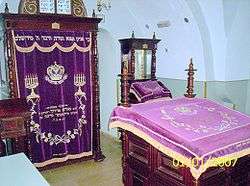Chaim ibn Attar
| Chaim ibn Attar | |
|---|---|
|
Grave of ibn Attar on the Mount of Olives, Jerusalem | |
| Personal details | |
| Born |
1696 Meknes, Morocco |
| Died |
7 July 1743 (aged 46–47) Jerusalem, Ottoman Empire |
| Buried | Mount of Olives Jewish Cemetery |

Ḥayyim ben Moshe ibn Attar also known as the Or ha-Ḥayyim after his popular commentary on the Pentateuch, was a Talmudist and kabbalist; born at Meknes, Morocco, in 1696; died in Jerusalem, Ottoman Empire on 7 July 1743. He was one of the most prominent rabbis in Morocco.
In 1733 he decided to leave his native country and settle in the Land of Israel, then under the Ottoman Empire. En route he was detained in Livorno by the rich members of the Jewish community who established a yeshiva for him. Many of his pupils later became prominent and furnished him with funds to print his Or ha-Ḥayyim.
He was received with great honor wherever he traveled. This was due to his extensive knowledge, keen intellect and extraordinary piety. In the middle of 1742 he arrived in Jerusalem where he presided at the Beit Midrash Kenesset Yisrael.
One of his disciples there was Rabbi Chaim Joseph David Azulai, who wrote of his master's greatness: "Attar's heart pulsated with Talmud; he uprooted mountains like a resistless torrent; his holiness was that of an angel of the Lord, ... having severed all connection with the affairs of this world."
He is buried in the Jewish Cemetery on the Mount of Olives, Jerusalem.
Works
- Ḥefetz Hashem (God's Desire), Amsterdam, 1732—dissertations on the four Talmudic treatises Berakhot, Shabbat, Horayot, and Ḥullin.
- Or ha-Ḥayyim (The Light of Life), Venice, 1742—a commentary on the Pentateuch after the four methods known collectively as Pardes; it was reprinted several times. His renown is based chiefly on this work, which became popular also with the Hasidim.
- Peri Toar (Beautiful Fruit), novellae on the Shulchan Aruch, Yoreh De'ah, dealing especially with Hiskiah de Silva's commentary Peri Ḥadash, Amsterdam, 1742; Vienna and Lemberg, 1810.
- Rishon le-Zion, Constantinople, 1750—consisting of novellae to several Talmudic treatises, on certain portions of the Shulḥan Arukh, on the terminology of Maimonides, on the five Megillot, on the Prophets and on Proverbs.
- Under the same title were published at Polna, 1804, his notes on Joshua, Judges, Samuel, and Isaiah.
See also
Bibliography
- Michael, Or ha-hayyim, No. 894;
- Benjacob, Otzar ha-Sefarim, p. 541;
- Luncz, in Jerusalem, i.122 (epitaphs);
- Nacht, Me'or Chayyim, Hebrew biography of 'Attar, Drohobycz, 1898;
- Azulai, Shem ha-Gedolim;
- Franco, Histoire des Israélites d'Orient
- Assaf, David (2009). "'A Heretic who has No Faith in the Great Ones of the Age': The Clash Over the Honor of or Ha-Hayyim". Modern Judaism. 29 (2): 194–225. doi:10.1093/mj/kjp003.
References
-
 This article incorporates text from a publication now in the public domain: Singer, Isidore; et al., eds. (1901–1906). "Attar, ibn". Jewish Encyclopedia. New York: Funk & Wagnalls Company.
This article incorporates text from a publication now in the public domain: Singer, Isidore; et al., eds. (1901–1906). "Attar, ibn". Jewish Encyclopedia. New York: Funk & Wagnalls Company.
External links
- Or haHayyim: Creativity, Tradition, and Mysticism in the Torah Commentary of R. Hayyim ibn Attar
- Ohr ha-Chaim book in text files in Hebrew.